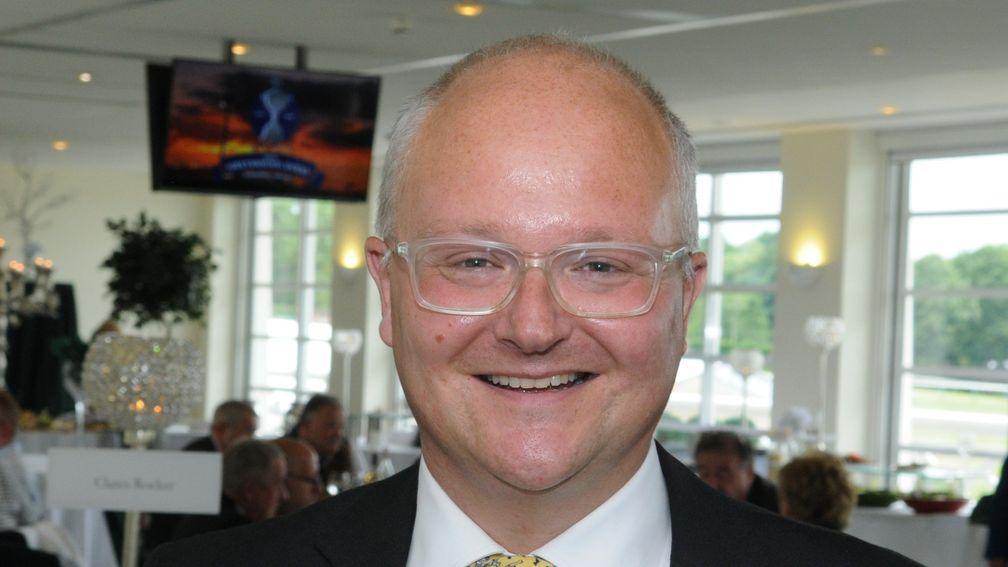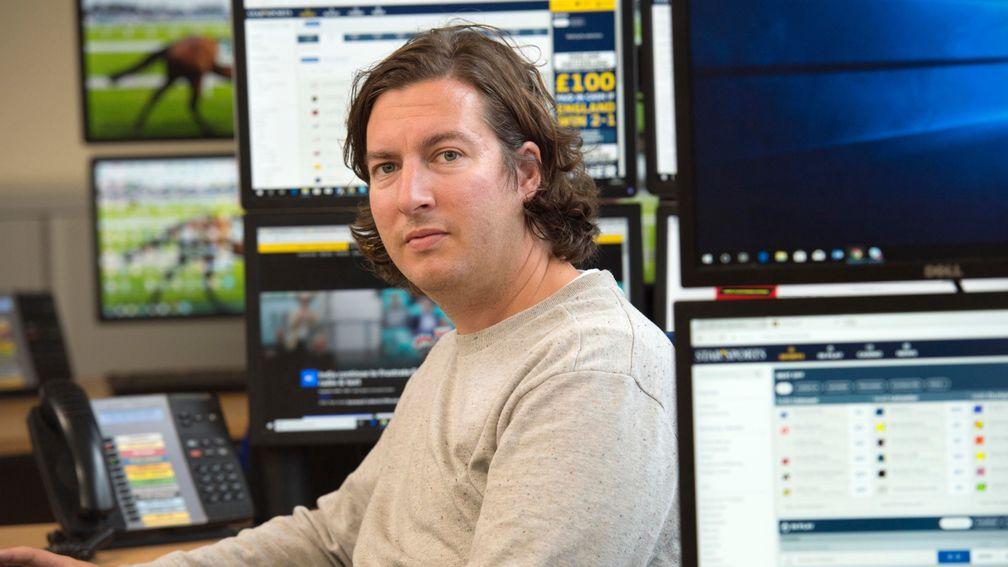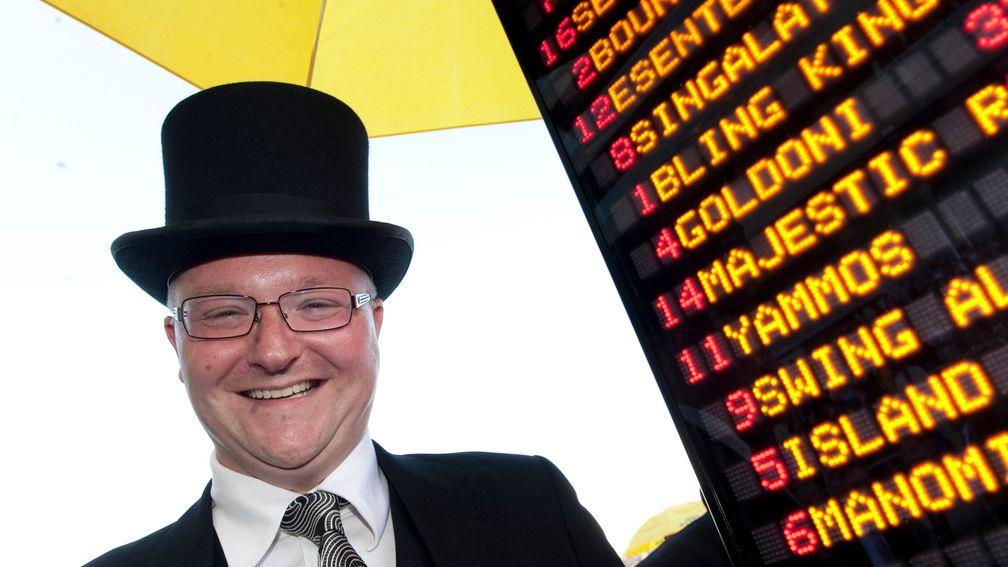Big bets, big calls, big pressure – a day with the traders at Star Sports

On the eighth day of Christmas, Racing Post gave to me . . . a look behind the scenes on the trading floor as part of our Betting Today series – first available to Members' Club subscribers on September 19, 2018. Click here for more information and to sign up
It is early afternoon, midweek, the third race of the day and eyes are on the second favourite in a maiden hurdle.
Two flights from the finish and the 9-4 chance is being pushed along behind the odds-on favourite who is cruising in front.
"It’s well beat," says Alex, one of the traders, as the runners turn for home.
But at the second-last a cry goes up in the trading room of bookmaker Star Sports. There are swear words involved. The odds-on favourite has fallen, handing the race to the 9-4 shot.
For the Brighton-based layers it is an expensive moment. "That’s cost us £21,000," says head of horseracing Sam Spitalfield. "We wanted the odds-on jolly to beat the second favourite. If the favourite had won we would have won £9,000. So there’s a £30,000 swing. That’s from two bets. And that can happen multiple times in a day."
The shoppers down the road near Portslade station, in an ordinary suburb of Brighton, will have little clue about what goes on in a group of industrial units around a quadrangle in a converted school up on the Old Shoreham Road. But at the home of Star Sports winning and losing money, often big money, is their business.
The trading room is unfussy – four rows of desks crammed with screens, with chairs pointing towards the action on the wall showing cricket, golf and racing. In the room are traders making decisions about markets and bets on which the success of the business turns.
"Any big bets, liabilities that take out £30,000 or more, must be sent to the boss before a race," explains Spitalfield. "He lets you get on with it, but he just wants to know. And he wants to know the result."
The boss is Ben Keith, originally a greyhound bookie, who started Star Sports 19 years ago. They have pitches at Cheltenham and Royal Ascot, and a new, prominent one at the Curragh, but the success of the business has been built around taking lumpy bets over the phone.

Since February they have been online too, considerably increasing the number of employees to 55 – a big enough pool for a staff cricket team – and allowing them to capture more casual punters.
In the trading room the volumes on the big screens are turned to mute. Cries of "ten bags on the jolly" and "he’s got his £11,000 on" fill the space. "Stay out of the frame," calls a trader about a runner carrying a big each-way liability. It doesn’t.
Getting bets on
Star Sports have many clients and each one, from those betting pennies to the high rollers, has a rating that is the starting point for determining their bet limit. Each client starts with a rating of one, which is adjusted depending on the nature and success of their bets.
As a crude rule of thumb a punter with a rating of two could bet twice as big as someone rated one. And one with a rating of 0.5 could have half as much on.
The rating is factored against the strength of the market. The more liquid and well formed the market, the bigger the acceptable bet.
Spitalfield explains: "When the day kicks off at 8.30am the whole team go through the morning prices and from the word go we’re making adjustments and taking bets. Some people have large stakes first thing in the morning. We will have very important clients calling.
"Every race has to be given a limit based on its market strength, which is the basis for how much a client can have on.
"Each client has a rating which is used as a guide to how much they can bet, measured against the race limit. All clients start with a rating, which develops up or down from there depending on how they bet."
When a client seeks a bet bigger than their race-adjusted limit it gets referred, triggering quickfire discussions in the trading room about what should be permitted.
"The trader looks at the client’s profile and perhaps has a discussion with other traders about what kind of bet might be accepted above their limit or not," says Spitalfield. "So the trader has the option to be flexible and less defensive.
"We might, for instance, offer them a smaller bet than they wanted or for the amount they wanted but not at the same price. So we might offer them £50 each-way rather than the £100 each-way they wanted or offer them the full bet at SP. But we’re not sticklers for pre-arranged limits."
Punters are instantly informed of the decision on the phone or, if they are betting online, via a chat facility with the trader.
Digging for evidence
Individual client ratings are shaped not just by results but betting patterns. When a punter is particularly successful their staking history is subject to rigorous analysis.
Spitalfield, who claims the number of Star Sports accounts that have been closed is in single figures, says: "Some clients show attributes where they beat us time and time again. So we do mini case studies into their betting patterns. We’ll look at things like the time they bet and the price when they bet. Considering patterns like the jockey or trainer is a last resort.
"By doing this you can tell how much bearing that client is having over the market. If they are beating the market in top events, getting evens every time about an 8-11 chance, then they must be close to the top of the food chain.
"An influential tipster will have a bearing over a big market purely because of the weight of money, where everyone wants £10 on their tip on a Saturday.
"But if you have someone reshaping a small market in midweek, where a horse has gone from, say, 5-1 into 9-4, it tells you something else.
"One client is winning well at the moment but could obtain bigger prices at the off than when he bets. So even though he is winning now, the mathematics tell us we will catch up.
"But if someone has ten wins on the spin and each time they are getting the best price, then we will look at their rating and trade them harder."
Always on guard
Specials and ante-post markets tend to be framed in quieter periods during the morning, although the trading room drill is to be constantly alert.
Spitalfield says: "We had to react suddenly when, at the beginning of the day’s play before he got his hundred in the Oval Test, we started seeing a lot of money at 100-1 for Alastair Cook to be Sports Personality of the Year. He got shortened to 14-1."
Before pizza is shipped in for lunch, the destination of that SPOTY prize is argued over. One trader cannot have Tour de France winner and favourite Geraint Thomas. The other decries Harry Kane’s chances. Cook it is, then.
Back on the floor there are other snares for the traders, like arbitrage bets and bad-each ways – bad for the layer, that is.
"For us as bookmakers, if we are laying a price above the exchange then we are going to lose money in the long run," Spitalfield explains. "When that happens as the market takes shape it offers an arbitrage opportunity for someone to take advantage of.
"With the arbers, as soon as they are having a bet they are doing so with an in-built edge against the bookmaker. It’s the same with bad each-ways. They are playing a long-term game."
There is pressure on the traders there, but the real heat comes around the middle of March. "The busiest time is Cheltenham," says Spitalfield, "the phones are ringing all the time and the high rollers all want to play. You’re making big decisions quickly.
"New clients always come out of the woodwork at Cheltenham and we have to decide whether they are good or bad business. You don’t want to get someone wrong at Cheltenham."
FOBTs: who needs them?
Star Sports have just one shop and its location is a secure windbreak against the storms ready to blow through the retail sector of the betting industry.
Two years ago its name arrived above the door of one of the most iconic betting shops in the business when residence was taken up from Victor Chandler in the Deanery Street premises near Mayfair’s Dorchester Hotel.
The reduction of maximum stakes on FOBTs from £100 to £2 is forecast to close thousands of betting shops that have become reliant on their activity. But the Mayfair shop will not be one of them.
"We have four FOBTs in there and they rarely get played, so the changes won’t affect us," says Luke Tarr, Star Sports’ head of PR. "The shop has high-rolling punters and is like a plush airport lounge with fruit on the table."

Star Sports avoided the blow felt by offshore-based rivals over the capture of levy from their activities because, as a British-based business, they already paid it.
So instead of being defensive they have had the confidence to expand, buying big pitches and starting a website.
"We have a lot of clients with big profiles who we are happy to go into battle with that others won’t," says Tarr. "We work on smaller margins based on the principle that we would rather get three per cent of £1 million than 20 per cent of £1,000. We are happy to assess punters that cannot get on elsewhere.
"At Cheltenham we took £600,000 at 1-6 on Douvan to win the Champion Chase and £400,000 at 2-7 on Altior for the Arkle. That’s because the markets are rock-solid. But in the 6.15 at Wolverhampton it’s different.
"If you play when the market is stabilised it’s fair, but when it’s not, ultimately the punter will win and the bookie will go out of business."
While the launch of a website reflects a diversification in approach, Tarr insists it does not mean a change in ethos.
"While others went the £10 and £20 way we went the £1,000 and £2,000 route," he says. "Now we’re looking to grow the other side.

"For ten to 12 years everyone has known we are the largest layers in the ring. People have had the perception that we’re an elitist club but we take 10p Yankees as well as your £50,000 at evens on Man City.
"And we’ve prided ourselves on having the same attitude towards everyone, calling them by their names and not a number and not making it faceless.
"It’s a game. The bookies want the punters’ money and the punters want the bookies' money. But we have to be socially responsible. We’re not looking to rip people’s throats out and we have an ever-growing compliance team."
Younger audience turning to racing
Racing remains the dominant product for Star Sports despite the growth of football betting.
Head of trading Dave Jolly, who spent 20 years at Ladbrokes before moving south, believes after a period of stagnation that interest in racing is growing among a younger audience
"Racing is the top product, football is second," he says. "Then come things like cricket, golf and tennis. Racing turnover is solid, it is only proportionally in decline because of the growth of football. But we will not lose sight of the fact that racing is the backbone of the business.
"We have lots of younger customers attracted to the sport now. At one time you could count the number of under-30s on one hand. But now we have what we call VIP punters from their early-20s right the way through. People are comfortable with staking and enjoying racing."
Jolly thinks the ease of digital betting and better promotion is helping racing catch up with other sports. "I think it has partly been racing’s own fault. It didn’t lend itself to the modern era," he says.
"It’s a challenge because the 18-year-olds now grow up on the Premier League. I grew up on the ITV7. There’s also the range of markets. A single football match can have 300 markets, but you’re looking at six markets at best for one race.
"ITV’s coverage has helped by putting racing in the front line. They talk to the common man and have done away with the pompousness. It’s more about the horses and jockeys.
"I think people can relate more to racing than ever before. Things like concert nights have helped attract interest. I think the sport now is in a more healthy position than it has been for a long time."
For the freshest betting advice, based on latest going and market conditions, don't miss the Live Tipster. Just click Raceday Live at racingpost.com or on the mobile app
Published on 1 January 2019inSeries
Last updated 19:40, 31 December 2018
- We believed Dancing Brave could fly - and then he took off to prove it
- 'Don't wind up bookmakers - you might feel clever but your accounts won't last'
- 'There wouldn't be a day I don't think about those boys and their families'
- 'You want a bit of noise, a bit of life - and you have to be fair to punters'
- 'I take flak and it frustrates me - but I'm not going to wreck another horse'
- We believed Dancing Brave could fly - and then he took off to prove it
- 'Don't wind up bookmakers - you might feel clever but your accounts won't last'
- 'There wouldn't be a day I don't think about those boys and their families'
- 'You want a bit of noise, a bit of life - and you have to be fair to punters'
- 'I take flak and it frustrates me - but I'm not going to wreck another horse'